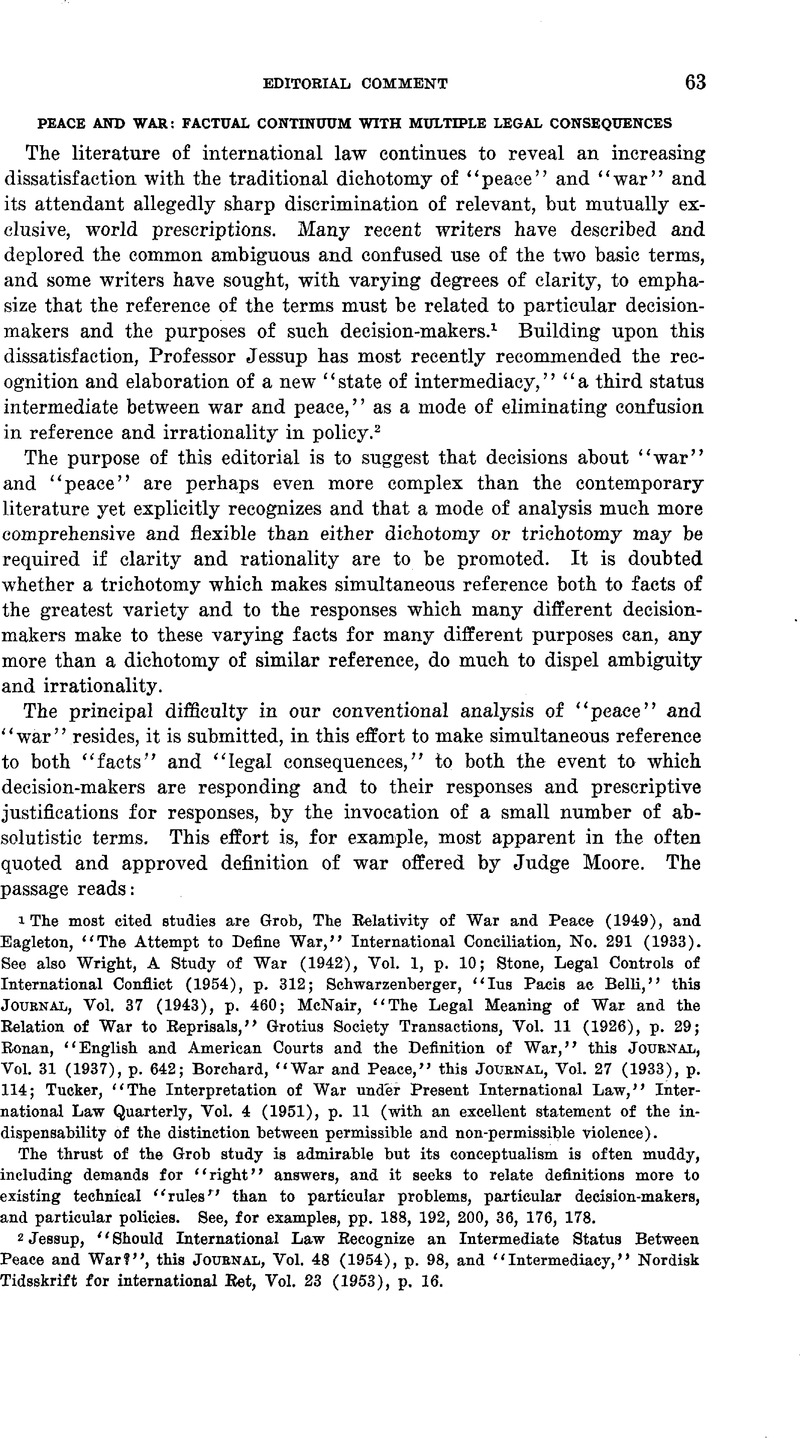Article contents
Peace and War: Factual Continuum with Multiple Legal Consequences
Published online by Cambridge University Press: 30 March 2017
Abstract

- Type
- Editorial Comment
- Information
- Copyright
- Copyright © American Society of International Law 1955
References
1 The most cited studies are Grob, The Relativity of War and Peace (1949), and Eagleton, “The Attempt to Define War,” International Conciliation, No. 291 (1933). See also Wright, A Study of War (1942), Vol. 1, p. 10; Stone, Legal Controls of International Conflict (1954), p. 312; Schwarzenberger, “Ius Pacis ae Belli,” this Journal, Vol. 37 (1943), p. 460; McNair, , “The Legal Meaning of War and the Relation of War to Reprisals,” Grotius Society Transactions, Vol. 11 (1926), p. 29 Google Scholar; Ronan, , “English and American Courts and the Definition of War,” this Journal , Vol. 31 (1937), p. 642 Google Scholar; Borchard, , “War and Peace,” this Journal , Vol. 27 (1933), p. 114 Google Scholar; Tucker, , “The Interpretation of War under Present International Law,” International Law Quarterly, Vol. 4 (1951), p. 11 Google Scholar (with an excellent statement of the in-dispensability of the distinction between permissible and non-permissible violence).
The thrust of the Grob study is admirable but its conceptualism is often muddy, including demands for “right” answers, and it seeks to relate definitions more to existing technical “rules” than to particular problems, particular decision-makers, and particular policies. See, for examples, pp. 188, 192, 200, 36, 176, 178.
2 Jessup, , “Should International Law Recognize an Intermediate Status Between Peace and War?”, this Journal , Vol. 48 (1954), p. 98 Google Scholar, and “Intermediacy,” Nordisk Tidsskrift for international Ret, Vol. 23 (1953), p. 16.
3 Moore, Digest of International Law, Vol. 7 (1906), p. 153.
4 Thus Hyde, International Law (2d rev. ed., 1945), Vol. 3, p. 1686: “A state of war is a legal condition of affairs dealt with as such, and so described both by participants and non-participants.”
Eagleton (above, note 1) offers a wide selection of such definitions of varying dates.
Wright early recognized the need for distinguishing war “in the material sense” from war “in the legal sense.” “Changes in the Conception of War,” this Journal, Vol. 18 (1924), pp. 755, 762. He further emphasizes this need in his two-volume study, but he also makes frequent use of a definition which runs: “War is a legal condition which equally permits two or more hostile groups to carry on a conflict by armed force.” Wright, A Study of War (1942), Vol. 2, p. 698. See also Vol. 1, p. 8.
Contrastingly, overemphasis upon the facts of coercion, and underemphasis upon the rôle of decision-makers, is apparent in Professor Borchard’s occasionally quoted query. “Is it not a strange doctrine that would make the existence of war depend on recognition by anybody?” Loc. cit., note 1, above. Quoted in Briggs, The Law of Nations (2d rev. ed., 1951), p. 975.
5 Thus, Komarnieki, “The Place of Neutrality in the Modern System of International Law,” Hague Academy of International Law, Recueil des Cours (1952), p. 401: “Neutrality is a legal status involving certain rights and duties.” Cf. Stone (note 1, above), at p. 380.
6 The mode of analysis here suggested reflects collaborative work with the writer’s colleague, Professor Harold Lasswell, and with his students, Florentino P. Feliciano, William T. Burke, and Peter Stern.
7 Coercion, as contrasted with persuasion, may be taken to refer to constraint imposed either by severe deprivations or by threats of such deprivations. Such ancillary concepts as force, violence, and conflict may be taken to refer, respectively, to coercion directed against the well-being of the target, to intense uses of force, and to aggregates of people in which the use of any form of coercion is intense.
8 Appropriate modification of this statement might of course be made to take into account the internal conflicts commonly described as civil war.
9 Description in terms of a continuum is employed by both Schwarzenberger and Wright, cited above, note 1.
10 Some of the difficulties that others have found with states of intermediacy are recounted by Komarnicki, loc. cit. (note 5, above), Ch. II.
One can only marvel at the restraint of Stone, who writes “… it is likely that clarity will only be approached in this problem by recognizing that the question ‘War or No War?’ may have to be answered differently according to the purposes for which an answer is sought”; but concludes that “No such differentiation can be said as yet to have emerged in practice.” Op. cit. (note 1, above), at pp. 312, 313.
11 Some amplification of what is intended by these “intellectual tasks” is offered in McDougal, “International Law, Power, and Policy,” Hague Academy of International Law, Recueil des Cours (1953).
- 5
- Cited by




